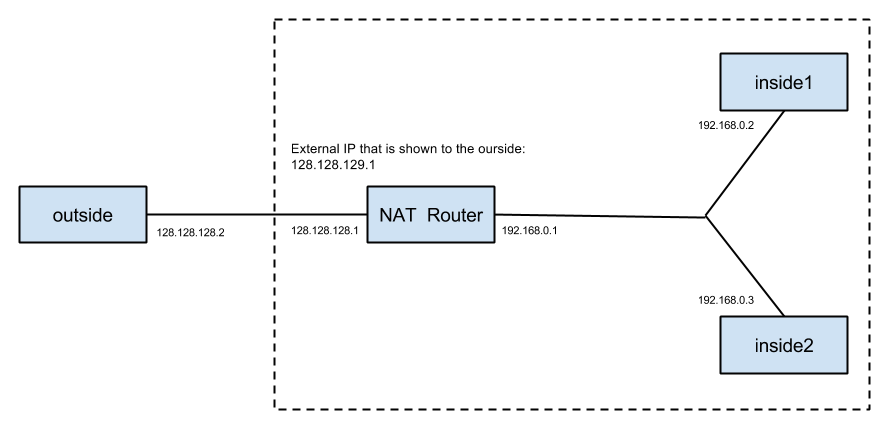| Version 2 (modified by , 10 years ago) (diff) |
|---|
OpenFlow NAT using Trema Example

|

|

|
STEPS FOR EXECUTING EXAMPLE
In this section, we are going to build a router for a netwrok with a private address space that needs a one-to-many NAT (IP Masquerade) for some reason (e.g. short on public IP space or security) using OpenFlow. As shown in the figure below, hosts inside1 and inside2 are part of the private network, while host outside is outside. The LAN has only one public IP — 128.128.129.1. (The external IPs we use, 128.128.128.0/24 and 128.128.129.0/24, are just an example. If your public IP happens to be in this subnet, change them to others.)

1 Test reachability before starting controller
1.1 Login to your hosts
To start our experiment we need to ssh into all of our hosts. Depending on which tool and OS you are using there is a slightly different process for logging in. If you don't know how to SSH to your reserved hosts take a look in this page. Once you have logged in, follow the rest of the instructions.
1.2 Test reachability
- First we start a ping from
inside1toinside2, which should work since they are both inside the same LAN.inside1:~$ ping 192.168.0.3 -c 10
- Then we start a ping from
outsidetoinside1, which should timeout as no according routing information in its routing table. You can useroute -nto verify that.outside:~$ ping 192.168.0.2 -c 10
- Similarly, we cannot ping from
insideXtooutside.
- You can also use Netcat (
nc) to test reachability of TCP and UDP. The behavior should be the same.
2 Start controller to enable NAT
2.1 Access a server from behind the NAT
You can try to write your own controller to implement NAT. However, we've provided you a functional controller, which is a file called nat.rb under /tmp/ .
- Start the controller on
NAThost:nat:~$ trema run /tmp/nat.rb
You should see following log after the switch is connected to the controller
rule added to switch for arp and ipv6 pkt: send normally
which means we ask the switch to forward ARP and Ipv6 packets normally, and only perform NAT for TCP, UDP and ICMP.
- On
outside, we start a nc server:outside:~$ nc -l 6666
and we start a nc client on inside1 to connect it:
inside1:~$ nc 128.128.128.2 6666
- Now send message between each other and try the same thing between
outsideandinside2.
- On the terminal of
switch, in which you started your controller, you should see a log similar to:Created mapping 192.168.0.3 31596 to 128.128.129.1 59997
Note that there should be only one log per connection, because the rest of the communication will re-use the mapping.
3 Handle ARP and ICMP
One of very common mistakes that people make, when writing OF controller, is forgetting to handle ARP and ICMP message and finding their controller does not work as expected.
3.1 ARP
As we mentioned before, we should insert rules into the OF switch that allow ARP packets to go through, probably after the switch is connected (see event handler switch_ready).
3.2 ICMP
Handling ARP is trivial as NAT does not involve ARP. However, it's not the case for ICMP. If you only process translation for TCP/UDP, you will find you cannot ping between outside and insideX while nc is working properly. Handling ICMP is even not as straightforward as for TCP/UDP. Because for ICMP, you cannot get port information to bind with. Our provided solution makes use of ICMP echo identifier. You may come up with different approach involves ICMP sequence number or others.
- On
inside1, start a ping tooutside.inside1:~$ ping 128.128.128.2
- Do the same thing on
inside2.inside2:~$ ping 128.128.128.2
You should see both pinging are working.
- On
outside, usetcpdumpto check the packets it receives.outside:~$ sudo tcpdump -i eth1
You should see it's receiving two groups of icmp packets, differentiated by icmp_id.
Next: Teardown Experiment
Attachments (1)
- openflow-nat.png (30.3 KB) - added by 10 years ago.
Download all attachments as: .zip
